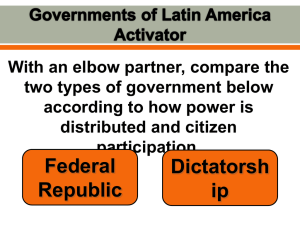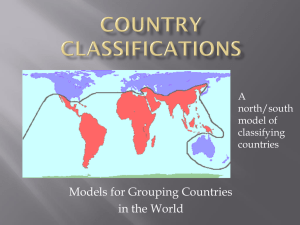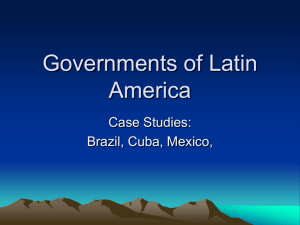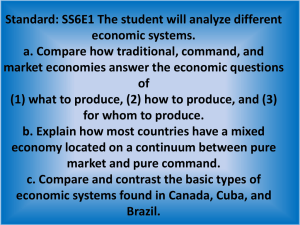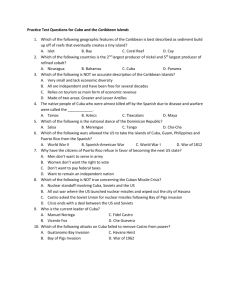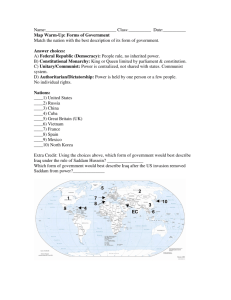National Governments in Latin America
advertisement
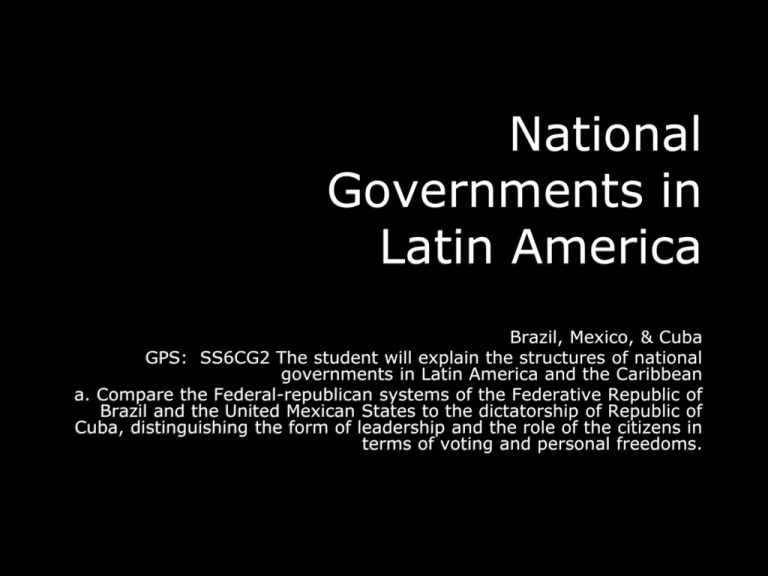
National Governments in Latin America Brazil, Mexico, & Cuba GPS: SS6CG2 The student will explain the structures of national governments in Latin America and the Caribbean a. Compare the Federal-republican systems of the Federative Republic of Brazil and the United Mexican States to the dictatorship of Republic of Cuba, distinguishing the form of leadership and the role of the citizens in terms of voting and personal freedoms. Federative Republic of Brazil • Federal republic: power is divided between the central government & state governments • Presidential democracy: citizens elect president & members of the legislature (Congress) Dilma Rouseff • First woman president of Brazil • Assumed office January 1, 2011 • Serves a 4-year term • Can be reelected once Brazil • Citizens have many freedoms & they also have the right to vote • Men & women who are 16 years of age may choose to vote, and citizens 18-70 are required by law to vote • Citizens can choose representatives from many political parties Brazil • Country enjoys average level of freedom compared to other countries in the world • Level of Personal Freedom = 59 – (1 = most free, 159 = least free; World average is 57) – Scale examines freedom to travel & trade, protection of personal property rights, freedom to conduct business, & taxation level – US = 8 • Personal property rights are not always protected, and the court system cannot be trusted to help people in all cases Government of the United Mexican States • Federal republic: power is divided between the central government & state governments • Presidential democracy: citizens elect president who serves 1 six year term – Also elect members of the legislature (Congress) Felippe Calderon • Assumed office December 1, 2006 • Serves 1 six-year term • Cannot be reelected Mexico • Citizens of Mexico have many freedoms, and they also have the right to vote • Citizens who are 18 or older may choose to vote • There are many political parties Mexico • Country enjoys an average level of freedom compared to other countries in the world • Level of Personal Freedom = 52 – (1 = most free, 159 = least free; World average is 57) • Court system is managed by the central government, and is not totally independent of the president Government of the Republic of Cuba • Unitary government: power organized from a strong central government controls each of the smaller units in the country • Communist dictatorship: citizens do not elect the president Raul Castro • Power transferred to Raul Castro in 2008 by Fidel Castro • Serves for an unlimited number of terms Cuba • President is appointed by the National Assembly of People’s Power • Citizens may vote for members of the National Assembly of People’s Power, but only for candidates approved by the Communist Party of Cuba – Communist Party controls the central Cuba • Citizens have few freedoms • Men and women aged 16 and over may choose to vote, but have few choices • Only one political party (Communist Party) is allowed & it has been controlled by Fidel Castro and his brother Raul since 1959 Cuba • One of the least free countries in the world • Level of Personal Freedom = 157 – (1 = most free, 159 = least free; World average is 57) • Government controls nearly all aspects of life • There is little opportunity to own personal property • Government is large and controls Level of Personal Freedoms Credits • www.slideshare.net • Google images • www.stateofworldliberty.org/report /rankings.html
